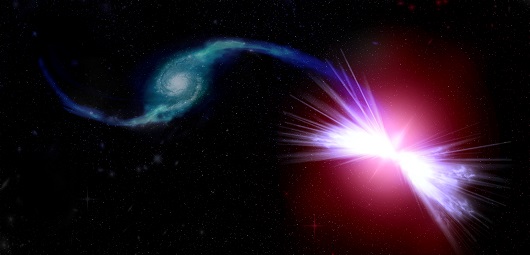Supermassive black holes cause galactic warming

An international team of astronomers, including Dr Anne-Marie Weijmans of the University of St Andrews, has discovered a new class of galaxies that could explain “galactic warming”.
For most of their lives, galaxies are lush environments for turning gas into stars. Until they aren’t.
Over the last few billion years, a mysterious kind of “galactic warming” has turned huge numbers of galaxies into deserts devoid of fresh young stars. The puzzle for astronomers has been identifying the unknown process that keeps the gas in these dormant galaxies too hot and energetic to form stars.
In a paper published in the journal Nature astronomers from the Sloan Digital Sky Survey (SDSS) announce the discovery of a new class of galaxies called “red geysers” that harbour supermassive black holes with winds that have the power to keep dormant galaxies quiet.
The secret to unlocking the mystery was the SDSS’s new component survey, Mapping Nearby Galaxies at Apache Point Observatory (MaNGA). Dr Anne-Marie Weijmans, of the University of St Andrews’ School of Physics and Astronomy, is lead observer for the survey and has been gathering data for the past two years.
Dr Weijmans said: “MaNGA is an ambitious survey, aiming to observe 10,000 galaxies in total. But because we observe such a large number of galaxies, we are able to catch the rare ones and discover new cases, such as these red geysers.”
Edmond Cheung, the lead author of the study, said: “We knew that there had to be a way to prevent star formation in these galaxies, and now we have a good idea of what it is.” Cheung, an astronomer at the University of Tokyo’s Kavli Institute for the Physics and Mathematics of the Universe, was working with the international team when they caught a supermassive black hole blasting away at the cold gas in its host galaxy.
“Galaxies start out as star-making machines with a simple recipe: gas plus gravity equals stars,” says Kevin Bundy, co-author on the study and Principal Investigator of the new SDSS campaign that led to the discovery. “Here we have a galaxy that has everything it needs to form new stars, but is dormant. Why is that?”
Astronomers had long suspected that the reason had something to do with the supermassive black hole found at the centre of many galaxies, but solid evidence was lacking. One reason was that it used to be difficult to map the internal structure and motions of gas and stars throughout a galaxy.
“If we looked just at the centre of the galaxy like we used to, we could have learned about the central black hole, but we would have missed the story of how it affects the rest of the galaxy,” Cheung says. “Another reason is that the wind from supermassive black holes comes and goes quickly, so catching the wind red-handed is hard.”
Cheung nicknamed this premier example of a red geyser galaxy “Akira” after the famous Japanese manga comic character, an homage to both the MaNGA survey and his home institution in Japan. Akira has a companion galaxy that Cheung called “Tetsuo” for another character in the same manga. Akira is pulling gas away from Tetsuo, which fuels Akira’s supermassive black hole winds. The winds driven by Tetsuo’s gas are the reason that Akira is currently a red geyser galaxy. Bundy came up with the name “red geyser” because these wind outbursts reminded him of the sporadic eruptions of a geyser and because the failure to form new stars leaves the galaxy with only red stars.
As with global warming on Earth, galactic warming has long-term consequences for red geyser galaxies – their gas can no longer form new stars. “You can think of these winds as super-heating the atmospheres of galaxies,” Cheung says. “As soon as any gas starts to cool, it gets blasted by this wind, like water droplets turning to steam.”
The team theorises that this phenomenon is quite common in dormant galaxies. Therefore, our own Milky Way Galaxy may not be safe from this galactic warming – distant future generations may see our supermassive black hole turning our galaxy into a red geyser.
Notes to news editors
Image caption
An artist’s rendition of the galaxies: Akira (right) and Tetsuo (left) in action. Akira’s gravity pulls Tetsuo’s gas into its central supermassive black hole, fuelling winds that have the power to heat Akira’s gas. The action of the black hole winds prevents a new cycle of star formation in Akira.
Image credit: Kavli IPMU
Funding for the Sloan Digital Sky Survey IV has been provided by the Alfred P. Sloan Foundation, the U.S. Department of Energy Office of Science, and the Participating Institutions. SDSS- IV acknowledges support and resources from the Center for High-Performance Computing at the University of Utah. SDSS-IV is managed by the Astrophysical Research Consortium.
For background information, visit the Mapping Nearby Galaxies at APO (MaNGA) website.
Category Research